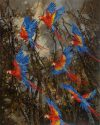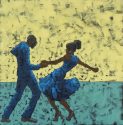Exhibitions
- Upcoming Exhibitions
- Past Exhibitions
- Current Exhibitions
John Alexander
John Alexander has been described as painting “nature at its grandest and man at his worst.” This exhibition of new paintings and works on paper embodies his continued passion for wildlife, flora and fauna, and the detail found within. Read More
Lin Emery
This exhibition of new work features pedestal and large-scale kinetic sculptures, as well as a water-activated fountain and theater installation. The elements in Lin Emery’s work continue to be derived from nature and she borrows natural elements – water, wind, magnets – to set them in motion. Besides searching the natural world, she explores history to create theater installations suggested by past worlds. The model for the “Mouth of Hell”, included in this exhibition, is derived from medieval images. Read More
John Pilson
Altogether Elsewhere brings together three projects which taken together represent the artist's long term interest in blurred distinctions between social documentary, experimental narrative and the many ways in which visual art and spontaneous performance are woven in to daily experience. Read More
Holton Rower
The paintings in Holton Rower's "Love Heals" compose an amazingly vibrant exhibition of works with incredible color combinations that can be stunningly psychedelic and completely hypnotic. The artist creates the paintings with a simple yet incredibly beautiful process that is carried out with variations in technique that produce wildly different effects. Read More
Rob Wynne
Rob Wynne’s debut exhibition with the gallery features recent poured mirrored glass texts and sculpted glass compositions, as well as earlier framed, embroidered canvases. The artist has a long-standing fascination with narrative. Utilizing words that resonate – overheard phrases and poetic quotations – he creates works that give a landscape to language. Read More
Jesús Moroles
Jesús Moroles considers granite “the core and heart of the universe.” His new sculptures exemplify his recognizable and revered technique, presented in small- to large-scale and utilizing a range of granite including Texas Pink, Dakota, Black and Fredericksburg. The abstract works continue to resound with suggestions of nature and man and explore the coexistence of the two. Trained formally in the United States and having spent a year in the quarries in Pietrasanta, Italy, Moroles is recognized internationally as one of the greatest sculptors working with granite today. Read More
Ersy
Ersy is revered for her work rooted in precise craftsmanship of materials including bronze, silver and wood. Scale, perspective and presentation play critical roles. The desired effect is that the viewer’s own size and relation to the piece become questioned. She recently received high critical praise for her 40-year retrospective at the Ogden Museum of Southern Art, “Ersy: Architect of Dreams.” Her exhibition at the Arthur Roger Gallery is based on work included in the retrospective. Read More
Joseph Havel
Joseph Havel’s sculptures exemplify the fluid condition between meanings, associations and the histories of common materials. Through reconfiguration of shape and material, everyday objects such as shirt labels, collars, flags and sheets present new impressions without erasing evidence of the originals. The intent of the artist “is for memory, an associative pentimento, to dissolve the resoluteness of the forms into something more poetic.” Read More
David Sullivan
David Sullivan’s animated paintings collapse the macrocosm into the microcosm. They are a collision of the gestural brushstrokes of abstract painting with the realism of 3D computer graphics. In the animations, humidity melts reified objects into states of transition. Refineries become atoms become organs become tumors. Like some will-o-the-wisp along the Mississippi River, seen dimly through the heat, ambiguous objects drip in a slowly evolving lightshow. Chemical reactions, in time and space, of molecules and Spanish moss glow over petrochemical plants. The industrial plants, their emissions and affected organs dissolve into one. Read More














